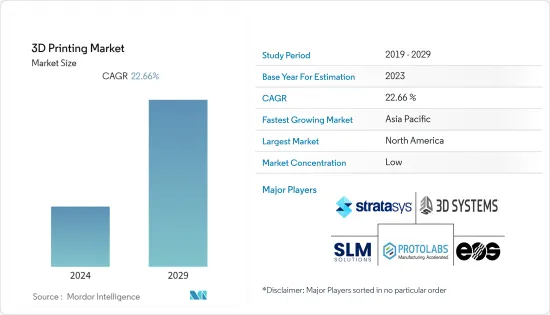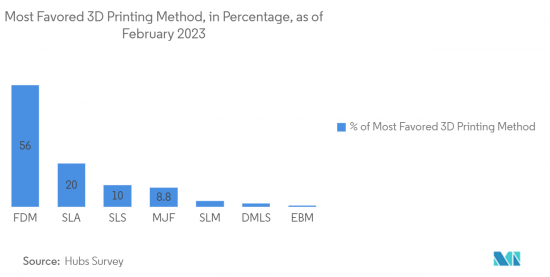 |
市場調查報告書
商品編碼
1403810
3D列印-市場佔有率分析、產業趨勢與統計、2024年至2029年成長預測3D Printing - Market Share Analysis, Industry Trends & Statistics, Growth Forecasts 2024 - 2029 |
||||||
※ 本網頁內容可能與最新版本有所差異。詳細情況請與我們聯繫。
3D列印市場規模預計本會計年度為202.4億美元,五年後為562.1億美元,預測期內複合年成長率為22.66%。
3D列印市場的成長歸因於主要製造商越來越傾向於使用該技術進行大規模生產。

主要亮點
- 隨著材料成分的快速進步,包括聚合物和金屬的新使用案例,積層製造正在從原型設計工具發展成為製造的功能部分。新材料、縮短的交貨時間和創新的表面處理使該技術能夠融入製造流程,同時符合標準(FDA、ASTM、ISO)。
- 此外,由於積層製造機器的價格下降、專業知識的增加和意識的提高,3D 製造的採用正在增加。更新、更先進的熔融沉積建模方法可以使用多種材料,這使得它們近年來在各個行業中被廣泛採用。
- 世界各國政府已經開始投資 3D 列印研發,對該技術的普及和採用產生了積極影響。例如,印度政府的目標是到 2022 年 2 月全球市場佔有率5% 的佔有率,在未來兩到三年內為 GDP 增加約 2-30 億美元。政府計劃在材料、機械、工藝和軟體方面創造 50 項本土技術,使印度成為 3D 列印設計和製造的中心。
- 然而,隨著技術的進步,積層製造對傳統的智慧財產權(IP)保護提出了挑戰。預計這將大大增加印刷武器和毒品的非法使用並阻礙市場成長。該市場也受到實現大規模規模經濟所需的高資本成本的抑制因素。此外,缺乏規範製造商的國際標準化機構限制了市場的標準化結構。
- COVID-19大流行增加了對 3D 列印的需求。 3D 列印系統正迅速被用來製造醫療設備、個人防護設備(PPE)、測試設備,甚至用於隔離病人的緊急住房。人工智慧和機器學習等各種技術的進步進一步支持了 3D 列印設備的採用。
- 疫情對金屬和聚合物 3D 列印市場造成了沉重打擊。儘管金屬和聚合物的成長速度低於疫情前的預期,但隨著最終用戶產業需求的增加,這些市場正在迅速復甦。
3D列印市場趨勢
印刷技術和材料的快速進步推動市場
- 生產技術和材料的快速開拓正在推動3D列印市場的需求。世界各地的 3D 列印技術和材料正在快速發展,為 3D 列印和創造複雜的自訂設計產品開闢了新的可能性。
- 例如,選擇性雷射燒結(SLS)和直接金屬雷射燒結(DMLS)等新型列印技術使得製造高精度的複雜金屬零件成為可能。這為汽車、航太和國防工業的 3D 列印帶來了新的機會。隨著太空探勘經歷範式轉變,更多國家準備發射人造衛星,SLS列印的需求預計將增加。
- 碳纖維和石墨烯等新材料也正在開發用於 3D 列印。這些材料堅固且重量輕,適合各種應用。例如,碳纖維用於製造 3D 列印賽車零件,石墨烯用於製造 3D 列印醫療植入。例如,2022 年 11 月,馬薩諸塞州積層製造公司 Inkbit 在 Formnext 上宣布推出其最新的積層製造材料 Titan Tough Epoxy 85合成橡膠。這種材料可提高需要高精度和生產級機械性能的應用的性能。
- 列印技術和材料的快速進步是促進3D列印市場成長的主要趨勢之一。隨著這些技術的不斷發展,製造商將能夠將 3D 列印用於各種最終用途。

北美市場佔最大佔有率
- 北美地區預計將主導 3D 列印市場,因為它是該技術的早期採用者。一系列新產品的推出和創新預計將推動市場成長。全球多家3D列印解決方案供應商正在擴大在北美市場的業務,以提高其在市場的佔有率。
- 在美國市場,多家公司正加大對3D列印研發的關注。 2023年5月,西門子宣布更加重視其在美國的3D列印工作,透過系列積層製造製造加速美國積層製造的轉型。透過這些舉措,該公司致力於從根本上改變從產品到機器再到製造的端到端事物。
- 該地區還出現了北美醫療、航太和國防、工業和消費品產業的投資浪潮,預計這些產業將大幅成長。 2022 年 11 月,醫療科技新興企業Axial3D 獲得 1,500 萬美元融資,由 Stratasys 領投的 1,000 萬美元策略投資。兩家公司之間的合作預計將使醫院和醫療設備製造商更容易獲得針對患者的 3D 列印解決方案,並使其成為主流醫療解決方案。
- 此外,美國國家航空暨太空總署 (NASA) 等多個政府機構已經認知到,對 3D 列印技術的大量投資可以極大地促進太空應用和零重力技術的發展,從而推動市場成長。
- 在美國,健身追蹤器和智慧服裝也有望成為 3D 列印技術的驅動力。此外,不斷變化的消費者偏好和日益成長的客製化需求正在推動開發由 3D 列印技術支援的軟性錶帶和電子系統的需求,從而推動市場成長。
3D列印行業概況
3D列印市場分為全球參與企業和區域參與企業。 Stratasys Ltd、3D Systems Corporation、EOS GmbH、通用電氣公司 (GE Additive) 和 Sisma SPA 等市場主要企業正在透過聯盟、合併、收購和投資來維持其市場地位。
2023 年 4 月,聚合物 3D 列印解決方案的領導者之一 Stratasys Ltd. 收購了 Covestro AG 的積層製造材料業務。此次收購包括位於歐洲、美國和亞洲的研發設施和活動,以及全球開發和銷售團隊。
2022年10月,AML3D澳洲金屬3D列印擴大了與波音飛機製造商的合作關係。今年早些時候,波音公司委託 AML3D 進行 3D 列印鋁製原型飛機零件,作為密集測試程序的一部分。這是根據「飛行」部件的 AS9100D 品質保證要求進行測試的。根據這份契約,決定擴大計劃範圍,將 3D 列印零件涵蓋。
2022 年 6 月,總公司以色列的 Stratasys 計劃擴大其在印度的 3D 列印空間。公司客戶包括Ashok Leyland、Hero MotoCorp、AIIMS、Symbiosis、IITs等,在設計原型、製造工具和生產零件方面擁有豐富的經驗。
其他福利:
- Excel 格式的市場預測 (ME) 表
- 3 個月的分析師支持
目錄
第1章簡介
- 研究假設和市場定義
- 調查範圍
第2章調查方法
第3章執行摘要
第4章市場概況
- 市場概況
- 產業吸引力-波特五力分析
- 供應商的議價能力
- 買方議價能力
- 新進入者的威脅
- 替代品的威脅
- 競爭公司之間的敵對關係
- 產業價值鏈分析
- COVID-19 對市場的影響
第5章市場動態
- 市場促進因素
- 政府措施和支出
- 易於開發客製化產品
- 市場挑戰
- 初始成本高且缺乏技能
第6章市場區隔
- 依技術
- 立體光刻技術(SLA)
- 熔融沉積建模(FDM)
- 電子束熔煉
- 數位光處理
- 選擇性雷射燒結(SLS)
- 其他技術
- 依材料類型
- 金屬
- 塑膠
- 陶瓷
- 其他材料類型
- 按最終用戶產業
- 車
- 航太/國防
- 醫療保健
- 建築/施工
- 能源
- 食品
- 其他最終用戶產業
- 按地區
- 北美洲
- 歐洲
- 亞太地區
- 世界其他地區 中東/非洲
第7章競爭形勢
- 公司簡介
- Stratasys Ltd
- 3D Systems Corporation
- EOS GmbH
- General Electric Company(GE Additive)
- Sisma SPA
- ExOne Co.
- SLM Solutions Group AG
- Proto Labs Inc.
- Hewlett Packard Inc.
- Nano Dimernsion Ltd
- Ultimaker BV
第8章投資分析
第9章 市場機會及未來趨勢

The 3D Printing Market size was estimated at USD 20.24 billion in the current year to USD 56.21 billion in five years, registering a CAGR of 22.66% during the forecast period. This growth of the 3D printing market is pinned to the trend that large manufacturers are increasingly using the technology for mass production.
Key Highlights
- With rapid advancements in material composition, such as the emerging use cases of polymers and metals, additive manufacturing is evolving from a prototyping tool to a functional part of fabrication. New materials, shorter lead times, and innovative finishes while adhering to standards (FDA, ASTM, and ISO) enable the technology to be integrated into manufacturing processes.
- Further, the decreased prices of additive manufacturing-based machines, growing expertise, and awareness have increased 3D manufacturing adoption. Newer and advanced fused deposition modeling methods have enabled the use of diverse materials, thereby boosting widespread adoption across various industries over recent years.
- Governments worldwide have already started investing in R&D on 3D printing, which has positively impacted technology propagation and adoption. For instance, in February 2022, the government of India aims to capture 5% of the global market share in 3D printing by adding nearly USD 2-3 billion to the GDP in the coming 2-3 years. The government plans to create 50 India-specific technologies for material, machine, process, and software to make India a 3D-printed design and manufacturing hub.
- However, as technology advances, additive manufacturing challenges the traditional forms of Intellectual Property (IP) protection. It significantly boosts the illegal usage of printed weapons and drugs, which is expected to hinder the market's growth. Also, the market is constrained by the high equipment costs needed to achieve substantial economies of scale. Furthermore, the lack of an international standards body regulating manufacturers limits the market's standardization structure.
- COVID-19 pandemic increased the demand for 3D printing. 3D printing systems are rapidly being utilized to create medical devices, personal protective equipment (PPE), testing devices, and even emergency dwellings to isolate persons suffering from the disease. The various technological advancements, such as AI and ML, further augment the adoption of 3D Printing devices.
- The pandemic hit the metal and polymer 3D printing markets hard. Whereas growth has been slower for metals and polymers than pre-pandemic expectations, these markets are returning rapidly with growing demand from end-user industries.
3D Printing Market Trends
Rapid Advancement in Printing Technologies and Materials to Drive Market
- Rapid developments in production technologies and materials are helping to drive demand for the 3D printing market. The rapid growth of 3D printing techniques and materials is taking place worldwide, opening up new possibilities in 3D printing and creating complex and custom design products.
- For example, new printing technologies like selective laser sintering (SLS) and direct metal laser sintering (DMLS) make it possible to create complex metal parts with high precision. This is opening up new opportunities for 3D printing in the automotive, aerospace, and defense industries. With space exploration witnessing a paradigm shift, the demand for SLS printing is expected to mount, with an increasing number of countries gearing up to launch satellites.
- New materials like carbon fiber and graphene are also being developed for 3D printing. These materials are solid and lightweight, making them ideal for various applications. For example, carbon fiber is used to create 3D-printed racing car parts, and graphene is used to create 3D-printed medical implants. For instance, in November 2022, Inkbit, a Massachusetts-based additive manufacturing company, introduced its latest additive manufacturing material, the Titan Tough Epoxy 85 elastomer, at Formnext. This material improves performance for applications requiring high accuracy and production-grade mechanical properties.
- The rapid advancement in printing technologies and materials is one of the key trends contributing to the growth of the 3D printing market. As these technologies continue to develop, manufacturers can use 3D printing in various end-use applications.

North America Holds the Largest Share in the Market
- The North American region is expected to dominate the 3D printing market as the region is an early adopter of technology. A series of new product launches and innovations are expected to augment market growth. Several 3D printing solution providers worldwide are expanding their presence in the North American market for an enhanced market presence.
- Several players in the United States market are expanding their focus on 3D printing research and development. In May 2023, Siemens announced its increasing emphasis on 3D printing initiatives in the United States to accelerate the transformation of the US additive manufacturing industry through serial additive manufacturing. With these initiatives, the company is working on bringing fundamental changes to the landscape, end-to-end, from product to machine to manufacturing.
- The region is also witnessing a series of investments in North America's healthcare, aerospace and defense, industrial, and consumer products industries, which are expected to grow significantly. In November 2022, Med-tech start-up Axial3D received an investment round of USD 15 million led by a strategic investment of 10 million USD from Stratasys. The collaboration between the two companies would provide a combined offering to make 3D printing solutions that are patient-specific for hospitals and medical device manufacturers more accessible, pushing for its adoption as a mainstream healthcare solution.
- In addition, various government organizations, such as NASA, have identified that substantial investments in 3D printing technologies can contribute considerably to space applications and develop zero-G technologies, driving the market's growth.
- Fitness trackers and smart apparel are also expected to drive factors for 3D printing technology in the United States. Also, changing consumer preferences and a rising need for customization have brought about a need to create flexible bands and electronics systems that could be realized using 3D printing technology, thereby driving its growth.
3D Printing Industry Overview
The 3D printing market is fragmented with global and regional players. The key players in the market, like Stratasys Ltd, 3D Systems Corporation, EOS GmbH, General Electric Company (GE Additive), and Sisma SPA, among others, are making partnerships, mergers, acquisitions, and investments in the market to retain their market position.
In April 2023, Stratasys Ltd., one of the leaders in polymer 3D printing solutions, acquired Covestro AG's additive manufacturing materials business. The acquisition includes R&D facilities and activities, global development, and sales teams in Europe, the United States, and Asia.
In October 2022, AML3D Australian metal 3D printing expanded its partnership with Boing aircraft manufacturer. Boeing tasked AML3D earlier this year with 3D printing aluminum prototype airplane components as part of an intensive testing procedure. They were tested against the requirements of AS9100D quality assurance for 'fly' parts. Building on this contract, it has now been decided to broaden the scope of the project to include additional 3D-printed components, increasing the agreement's value by 150%.
In June 2022, Israel-based Stratasys planned the expansion of its 3D printing sector in India. Ashok Leyland, Hero MotoCorp, AIIMS, Symbiosis, and IITs are among the company's clientele, with extensive experience in design prototyping, manufacturing tools, and production parts.
Additional Benefits:
- The market estimate (ME) sheet in Excel format
- 3 months of analyst support
TABLE OF CONTENTS
1 INTRODUCTION
- 1.1 Study Assumptions and Market Definition
- 1.2 Scope of the Study
2 RESEARCH METHODOLOGY
3 EXECUTIVE SUMMARY
4 MARKET INSIGTHS
- 4.1 Market Overview
- 4.2 Industry Attractiveness - Porter's Five Forces Analysis
- 4.2.1 Bargaining Power of Suppliers
- 4.2.2 Bargaining Power of Buyers
- 4.2.3 Threat of New Entrants
- 4.2.4 Threat of Substitutes
- 4.2.5 Intensity of Competitive Rivalry
- 4.3 Industry Value Chain Analysis
- 4.4 Impact of COVID-19 on the Market
5 MARKET DYNAMICS
- 5.1 Market Drivers
- 5.1.1 Initiatives and Spending by the Government
- 5.1.2 Ease in Development of Customized Products
- 5.2 Market Challenges
- 5.2.1 High Initial Cost and Skill Shortage
6 MARKET SEGMENTATION
- 6.1 By Technology
- 6.1.1 Stereo Lithography (SLA)
- 6.1.2 Fused Deposition Modeling (FDM)
- 6.1.3 Electron Beam Melting
- 6.1.4 Digital Light Processing
- 6.1.5 Selective Laser Sintering (SLS)
- 6.1.6 Other Technologies
- 6.2 By Material Type
- 6.2.1 Metal
- 6.2.2 Plastic
- 6.2.3 Ceramics
- 6.2.4 Other Material Types
- 6.3 By End-user Industry
- 6.3.1 Automotive
- 6.3.2 Aerospace and Defense
- 6.3.3 Healthcare
- 6.3.4 Construction and Architecture
- 6.3.5 Energy
- 6.3.6 Food
- 6.3.7 Other End-user Industries
- 6.4 By Geography
- 6.4.1 North America
- 6.4.2 Europe
- 6.4.3 Asia-Pacific
- 6.4.4 Rest of the World
7 COMPETITIVE LANDSCAPE
- 7.1 Company Profiles
- 7.1.1 Stratasys Ltd
- 7.1.2 3D Systems Corporation
- 7.1.3 EOS GmbH
- 7.1.4 General Electric Company (GE Additive)
- 7.1.5 Sisma SPA
- 7.1.6 ExOne Co.
- 7.1.7 SLM Solutions Group AG
- 7.1.8 Proto Labs Inc.
- 7.1.9 Hewlett Packard Inc.
- 7.1.10 Nano Dimernsion Ltd
- 7.1.11 Ultimaker BV













